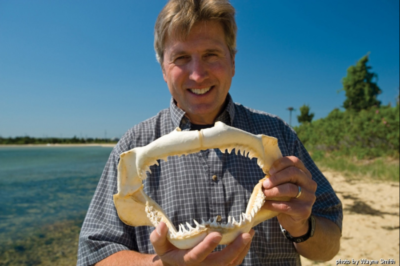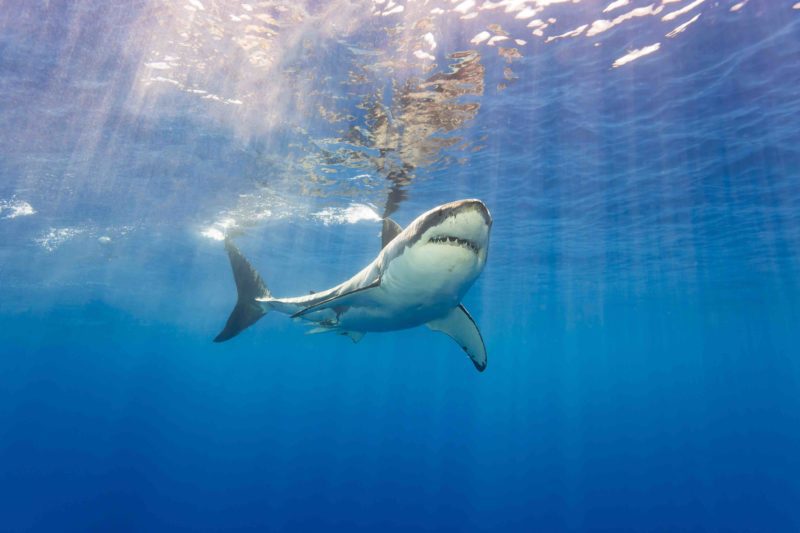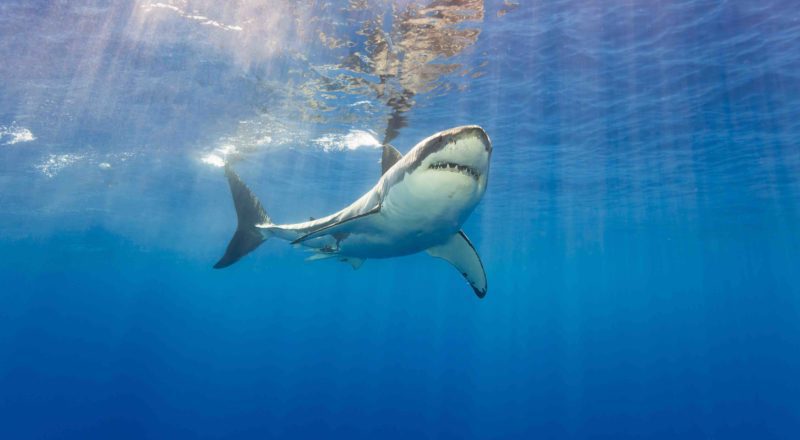INTERVIEW: Turning fear into fascination on Nat Geo’s SharkFest

It’s summertime, and that means shark TV programming is everywhere. Nat Geo Wild’s entry into the competition is called SharkFest, which kicks off with a splash Sunday, July 23 at 8 p.m. with the one-hour special Shark vs. Predator.
On the special, audiences can expect to dive into the world of animals that take on sharks. That’s right. In this special, the sharks become the prey. Included in the footage are scenes of seals, crocodiles, octopi, birds and even a bobcat all going toe to toe and fin for fin with the giant creatures of the deep blue. Nat Geo Wild promises the “ultimate underwater showdown,” but the winners in these bouts may surprise TV viewers.
Dr. Greg Skomal makes a living studying sharks, mostly the great whites off the coast of Cape Cod, Masachusetts. He’ll be featured in Shark vs. Predator, dishing out his expertise and explaining what’s happening in the amazing footage.
For Skomal, love of sharks goes back to when he was a child. “You get fascinated by things like dinosaurs and sharks, and you kind of outgrow it,” he said in a recent phone interview. “I think in my case, I never outgrew it. I became fascinated by sharks at a really young age.”
He cites Jacques Cousteau, Blue Water White Death, Jaws and The Deep as influences that led him to a career as a scientist who studies sharks.
Skomal is particularly excited for Shark vs. Predator. “Well, this is a cool show because the tables get turned on the sharks,” he said. “All too often we think of the sharks as the top dog or the big predator, and they are in most cases. But you also have to understand that there are things out there that eat sharks, and this film highlights that. And I think that the viewers are going to be fascinated by the fact that there are a variety of creatures that target sharks.”
The fear that so many swimmers have of sharks is largely an unfounded one, Skomal said. However, he goes a step further and says that fear of sharks is also primal, perhaps something built into the human psyche for thousands of years.
“It goes back to how we evolved as terrestrial land animals, and we look at the ocean as a foreign environment,” he said. “Survival is deep within us. We haven’t always lived in a modern society, and so removing that fear is almost impossible. … [The] statistical probability of getting hurt in a car is orders of magnitude higher than getting bitten by a shark. Yet we seem to have no problem jumping into our cars every day, and we fear sharks. So it’s interesting, but I think it’s the nature of these animals we fear. And, of course, it’s propagated by television, and other media and the Internet.”
The basic design of sharks, Skomal said, hasn’t changed in hundreds of millions of years, and that speaks to their optimal design and true success in the food chain. He called them powerful, sleek and well adapted to a tense environment.
“Their sensory capabilities are, I think, unparalleled by any other creature,” he said. “They have electro-sensory perception as well, so they’re really well adapted to finding prey and bait in an environment that is unforgiving. So when I look at a shark, I think it is a marvel of evolution and one that hasn’t changed. The basic design hasn’t changed much, but that tells me it hasn’t had to.”
For years, Skomal made his living on Martha’s Vineyard, an island off the coast of Massachusetts that was also the shooting location for Steven Spielberg’s Jaws. He still lives in the general area but calls the mainland his home. Today, he’s often plying the waters of the Northeast to find and study white sharks (scientists often drop “great” from the species name).
“We’ve been studying various aspects of their natural history — how they live from day to day, their behavior and their migratory patterns,” he said. “They’re seasonal pattern of distribution is very similar to Cape Cod tourists. They come here in June. Their peak season is July, August, September, and then as waters cool down, they migrate out of here. So it’s a very seasonal presence off the Cape, and it’s driven largely by water temperature. They prefer the warmer waters of summertime.”
It doesn’t hurt that Cape Cod has a healthy population of seals, which are scrumptious delights in the eyes of these behemoths.

In his early days, he would find himself on land studying specimens, but now the veteran scientist calls the open ocean his office. “The evolution of technology over the course of the last few decades has now increased our ability to basically follow the movements of these animals using the newer technologies,” he said. “So now we’re tagging live animals, and every day I go in the water I see live white sharks. And I’m saying that’s pretty awesome.”
The threat to swimmers is minimal, but that doesn’t mean the white sharks of Cape Cod are far off from the beaches. Skomal said there are numerous occasions in which his research is conducted in close proximity to swimmers on the beach.
“We share that information with swimmers immediately, and we’ve been trying to be proactive working with local towns as well as the National Park Service, which manages many of the beaches, as well as a nonprofit group called the Atlantic White Shark Conservancy, to educate the public,” he said. “The days of burying our heads in the sand and pretending white sharks aren’t out there are long over, and I believe that it’s critically important to get the word out. Tell people that we need to change our behavior to minimize the probability of an interaction with a white shark, and we need to learn how to coexist with the presence of this species. And I’m amazed at how the public has actually embraced that.”
He added: “Basically the reason the shark is here doing so well is because it’s an ecosystem success story. It means that some of the conservation measures put in place decades ago are actually working, and if you’ve got top predators thriving, it means you’ve got a well-balanced ecosystem. And that’s kind of nice because it’s not always the case.”
Over the years, Skomal has seen his fair share of big sharks. One only has to Google the shark name “Deep Blue” to see one of the great whites that Skomal has swam with in the wild. In the case of “Deep Blue,” the scientist actually tagged the shark a couple times off the coast of Mexico, and it was conservatively estimated as being up to 20 feet in length. “I can tell you that was one of the most impressive animals I’ve ever been in the water with,” he said.
For SharkFest, Skomal hopes that the programming helps the public turn their fears into the same inspiration that drove him into this field.
“The key to SharkFest programming is to engage people and get them thinking,” he said. “People think a lot about sharks, but let’s get them thinking about sharks the right way. Be fascinated like I am every day with my job, and once you engage people and you start educating them, you start turning minds around and shaping fear into fascination, and fascination into respect into conservation. So that’s what it’s all about for me, and that’s the importance of this kind of programming.”
By John Soltes / Publisher / John@HollywoodSoapbox.com
SharkFest begins Sunday, July 23 at 8 p.m. on Nat Geo Wild with the premiere of Shark vs. Predator, featuring Dr. Greg Skomal. Click here for more information.

